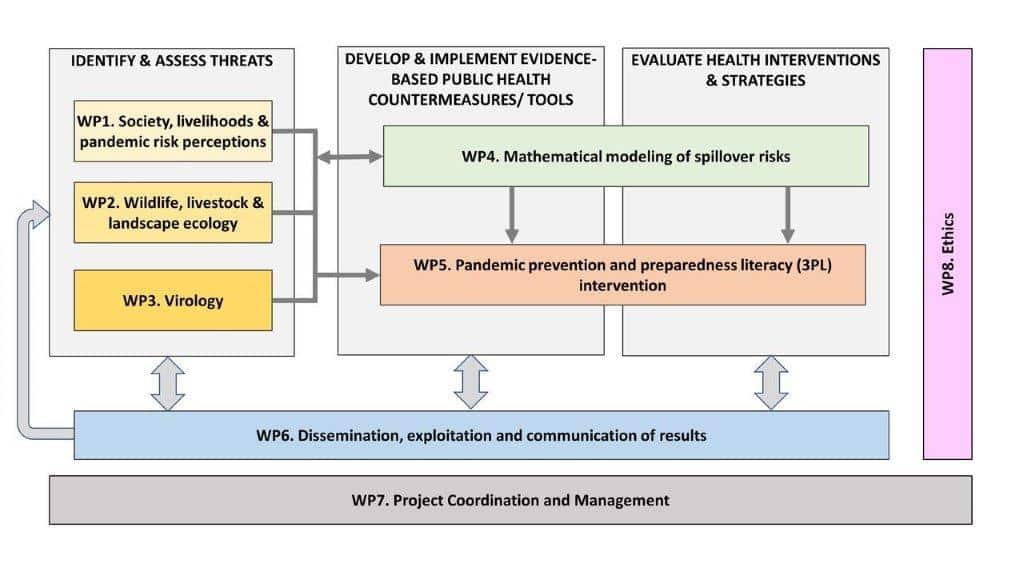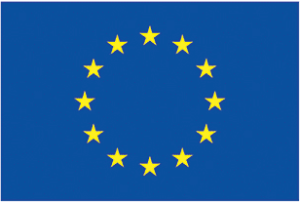Ambitions or Beyond State of Art
Figure 1. PANDASIA Work Packages
Specific Objectives of PANDASIA:
Specific Objective 1:
To determine and monitor human and societal factors impacting zoonotic spillover risk by identifying populations, human behaviours, human-animal-environmental interactions, structural drivers and barriers, and relevant policies in study locations (WP1).
Specific Objective 2:
To determine the most important wild and domestic vertebrate animal hosts of importance for spillover in each study location, assessing their presence, abundance, diversity (WP2).
Specific Objective 3:
To assess and model the potential effect of changes in land use, land cover, climate, and human demographic factors since the year 2000 on spillover risk (WP2).
Specific Objective 4:
To identify previously unrecognised pathogens with spillover potential, specifically targeting viral groups in vertebrate animal hosts for which there is strong precedence for viral occurrence and emergence in the region (WP3).
Specific Objective 5:
To develop ecological, epidemiological and evolutionary conceptual models to enhance understanding of the significance of the general principles and pathways of spillover processes, and to guide the development and analyses of a structurally equivalent, yet more specific, data-driven model (WP4).
Specific Objective 6:
To develop a point-of-care (POC) virus test kit prototype for use by healthcare providers and professionals to identify spillover at the earliest stages to prevent epidemic or pandemic spread (WP3).
Specific Objective 7:
To create and test a critical public health measure – a pandemic prevention and preparedness literacy (3PL) intervention to reduce zoonotic transmission and pandemic risk (WP5).
Outcomes and Impacts
Citizens will benefit from a reduced health threat of epidemics, both within and across borders. We will actively engage citizens in research and outreach, aiming to understand their role in preventing spillover risks and intervening effectively. PANDASIA intends to utilize these insights to develop user-friendly tools that facilitate the design of new prevention and risk reduction strategies. Moreover, the project will collaborate with stakeholders to co-design and evaluate interventions, specifically targeting the reduction of spillover risks and potential epidemics associated with various communicable health threats. The outcomes of this research will hold significant value for the global One Health community and enhance pandemic preparedness efforts. The study findings will be extensively disseminated in the study regions and throughout Europe in multiple languages. They will also be shared in reputable global scientific journals and conferences. Furthermore, leveraging the extensive network of collaborating and affiliated projects, the project will widely disseminate its findings among research and policy-making circles. The data, tools, and insights generated through these studies will be sustained beyond the project’s duration through open databases, providing indirect benefits to the wider community. By contributing to the implementation of SDG target 3.3, this project will actively support the achievement of sustainable development goals.
Additionally, citizens will benefit from an increased understanding of disease threats, active involvement in decision-making processes regarding their health, and the ability to shape policies and strategies based on knowledge-driven disease management. This is particularly crucial in controlling outbreaks and managing emergencies. PANDASIA aims to thoroughly investigate and engage with citizens, establishing interactive capacity-building platforms that promote knowledge development. These initiatives will benefit society as a whole and empower decision-makers. Furthermore, the project will extrapolate insights and tools from the study sites to benefit Europe and the global community. This approach will contribute to enhancing local and global control measures for outbreaks, epidemics, and emergencies by promoting effective, system-wide approaches across various sectors.
Table 1. Specific Objectives and Research Results of PANDASIA
| Specific Objectives | Research Results |
|
Specific Objective 1. Determine and monitor human and societal factors impacting zoonotic spillover risk by identifying populations, human behaviours, human-animal-environmental interactions, structural drivers and barriers, and relevant policies in study locations (WP1). |
RR1. Human and societal factors of importance for zoonotic spillover risk that may impact human, animal, and environmental health identified.
RR2. Key policies, policy actors, and stakeholders relevant to zoonotic spillover risk prevention and control measures at local and national levels identified.
RR3. Policymakers, relevant government sectors, local authorities, and communities engaged to obtain feedback and recommendations for the communication interventions. |
|
Specific Objective 2. Determine the most important wild and domestic vertebrate animal hosts of importance for spillover in each study location, assessing their presence, abundance, diversity (WP2). |
RR4. Presence and population characteristics of wild vertebrate and domestic animal hosts. |
|
Specific Objective 3. Assess and model the potential effect of changes in land use, land cover, climate, and human demographic factors since the year 2000 on spillover risk (WP2). |
RR5. Changes in historical land use, land cover, climate, and human population that may affect spillover events determined and modelled. |
|
Specific Objective 4. Identify previously unrecognised pathogens with spillover potential, specifically targeting viral groups in vertebrate animal hosts for which there is strong precedence for viral occurrence and emergence in the region (WP3). |
RR6. Ranked list of viruses with spillover potential with high binding affinity to host cell receptors and infection capacity based on in silico and wet lab-based criteria. RR7. Viruses with spillover potential identified and characterised in specific animal species and study locations. RR8. Identified viruses serving as empirical data to generate highly accurate risk models. RR9. Identified viruses u6sed as targets in Point of Care Test development. |
|
Specific Objective 5. Develop ecological, epidemiological and evolutionary conceptual models to enhance understanding of the significance of the general principles and pathways of spillover processes, and to guide the development and analyses of a structurally equivalent, yet more specific, data-driven model (WP4). |
RR10. A flexible epidemiological network model developed that captures essential steps of the spillover process. RR11. An ecological conceptual model developed that couples epidemiology and virulence evolution. RR12. Evolutionary and epidemiological frameworks integrated in a spatially explicit model relevant to study areas. |
|
Specific Objective 6. Develop a point-of-care (POC) virus test kit prototype for use by healthcare providers and professionals to identify spillover at the earliest stages to prevent epidemic or pandemic spread (WP3). |
RR13. ELISA protocol developed and used as a standard method to detect and identify spillover viruses. RR14. Prototype POC developed with high sensitivity and specificity compared to ELISA. |
|
Specific Objective 7. Create and test a critical public health measure – a pandemic prevention and preparedness literacy (3PL) intervention to reduce zoonotic transmission and pandemic risk (WP5). |
RR15. A conception (published as a policy brief and academic paper) of pandemic prevention and preparedness literacy. RR16. A co-created 3PL intervention (tested in a quasi-experimental causal impact evaluation, with a associated protocol and primary results papers and a policy brief and toolkit for implementation in other communities). |








